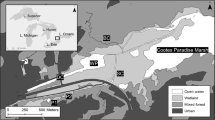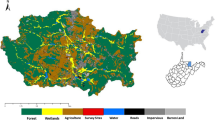Abstract
In order to effectively manage urban habitats, it is important to incorporate the spatial ecology and habitat use of the species utilizing them. Our previous studies have shown that the distribution of upland habitats surrounding a highly urbanized wetland habitat, the Central Canal (Indianapolis, IN, USA) influences the distribution of map turtles (Graptemys geographica) and red-eared sliders (Trachemys scripta) during both the active season and hibernation. In this study we detail the movements and habitat use of another prominent member of the Central Canal turtle assemblage, the common snapping turtle, Chelydra serpentina. We find the same major upland habitat associations for C. serpentina as for G. geographica and T. scripta, despite major differences in their activity (e.g., C. serpentina do not regularly engage in aerial basking). These results reinforce the importance of recognizing the connection between aquatic and surrounding terrestrial habitats, especially in urban ecosystems.



Similar content being viewed by others
References
Bodie JR (2001) Stream and riparian management for freshwater turtles. J Environ Man 62:443–455
Brooks RJ, Brown GP, Galbraith DA (1991) Effects of a sudden increase in natural mortality of adults on a population of the common snapping turtle (Chelydra serpentina). Can J Zool 69:1314–1320
Brown GP (1992) Thermal and spatial ecology of northern population of snapping turtles (Chelydra serpentina). MSc. Thesis, University of Guelph
Burke VJ, Gibbons JW (1995) Terrestrial buffer zones and wetland conservation: a case study of freshwater turtles in a Carolina Bay. Cons Biol 9:1365–1369
Cadi A, Joly P (2003) Competition for basking places between the endangered European pond turtle (Emys orbicularis galloitalica) and the introduced red-eared slider (Trachemys scripta elegans). Can J Zool 81:1292–1398
Congdon JD, Dunham AE, van Loben Sels RC (1993) Delayed sexual maturity and demographics of Blanding’s turtles (Emydoidea blandingii): implications for conservation and management of long-lived organisms. Cons Biol 7:826–833
Congdon JD, Dunham AE, van Loben Sels RC (1994) Demographics of common snapping turtles (Chelydra serpentina): implications for conservation and management of long-lived organisms. Amer Zool 34:397–408
Conner CA, Douthitt BA, Ryan TJ (2005) Descriptive ecology of a turtle assemblage in an urban landscape. Amer Midl Nat 153:428–435
DonnerWright DM, Bozek MA, Probst JR, Anderson EM (1999) Responses of turtle assemblage to environmental gradients in the St. Croix River in Minnesota and Wisconsin, U.S.A. Can J Zool 77:989–1000
Ernst CH, Lovich JE (2009) Turtles of the United States and Canada. Smithsonian Institution Press, Washington D.C
Feuer RC (1971) Ecological factors in success and dispersal of the snapping turtle Chelydra serpentina (Linnaeus). Bull Phil Herpetol Soc 19:3–14
Froese AD (1974) Aspects of space use in the common snapping turtle, Chelydra s. serpentina. Dissertation, University of Tennessee
Froese AD, Burghardt GM (1975) A dense natural population of the common snapping turtle (Chelydra s. serpentina). Herpetologica 31:204–209
Galbraith DA, Bishop CA, Brooks RJ, Simser WL, Lampman KP (1988) Factors affecting the density of populations of common snapping turtles (Chelydra serpentina serpentina). Can J Zool 66:1233–1240
Gibbs JP, Steen DA (2005) Trends in sex ratios of turtles in the United States: implications of road mortality. Cons Biol 19:552–556
Gordon DM, MacColluch RD (1980) An investigation of the ecology of the map turtle, Graptemys geographica (Le Sueur), in the northern part of its range. Can J Zool 58:2210–2219
Grant BW, Middendorf G, Colgan MJ, Ahmad H, Vogel MB (2011) Ecology of urban amphibians and reptiles: urbanophiles, urbanophobes, and the urbanoblivious. In: Niemela J (ed) Urban ecology. Oxford University Press, Oxford, pp 167–178
Grimm NB, Grove JM, Pickett STA, Redman CL (2000) Integrated approaches to long-term studies of urban ecological systems. Biosci 50:571–584
Grimm NB, Faeth SH, Golubiewski NE, Redman CL, Bai JWX, Briggs JM (2008) Global change and the ecology of cities. Science 319:756–760
Hammer DA (1969) Parameters of a marsh snapping turtle population Lacreek Refuge, South Dakota. J Wildlife Man 33:995–1005
Haxton T (2000) Road mortality of snapping turtles, Chelydra serpentina, in central Ontario during their nesting period. Can Field-Nat 114:106–110
Hays KA, Mcbee K (2010) Population demographics of red-eared slider turtles (Trachemys scripta) from Tar Creek Superfund Site. J Herpetol 44:441–446
Joyal LA, McCollough M, Hunter ML (2001) Landscape ecology approaches to wetland species conservation: a case study of two turtle species in southern Maine. Cons Biol 15:1755–1762
Klemens MW (1993) Amphibians and reptiles of Connecticut and adjacent regions. Bulletin 112 State Geological and Natural History Survey of Connecticut, Hartford, Connecticut
Kobayashi R, Hasegawa M, Miyashita T (2006) Home range and habitat use of the exotic turtle Chelydra serpentina in the Inbanuma Basin, Chiba Prefecture, Central Japan. Curr Herpetol 25:47–55
Linck MH, DePari JA, Butler BO, Graham TE (1989) Nesting behavior of the turtle, Emydoidea blandingii, in Massachusetts. J Herpetol 23:442–444
Lindeman PV (1999) Aggressive interaction during basking among four species of emydid turtles. J Herpetol 33:214–219
Lovich JE (1995) Turtles. In: LaRoe ET, Farris GS, Puckett CE, Doran PD, Mac MJ (eds) Our living resources: a report to the nation on the distribution, abundance, and health of U.S. plants, animals, and ecosystems. U.S. Department of the Interior, National Biological Survey, Washington, DC, p 902
Major PD (1975) Density of snapping turtles, Chelydra serpentina in western West Virginia. Herpetologica 31:332–335
Marchand MN, Litvaitis JA (2004a) Effects of habitat features and landscape composition on the population structure of a common aquatic turtle in a region undergoing rapid development. Cons Biol 18:758–767
Marchand MN, Litvaitis JA (2004b) Effects of landscape composition, habitat features, and nest distribution on predation rates of simulated turtle nests. Biol Cons 117:243–251
McKinney ML (2006) Urbanization as a major cause of biotic homogenization. Biol Cons 127:247–260
Meeks RL, Ultsch GR (1990) Overwintering behavior of snapping turtles. Copeia 3:880–884
Minton SA (2001) Amphibians and reptiles of Indiana. The Indiana Academy of Science, Indianapolis
Mitchell JC (1988) Population ecology and life histories of the freshwater turtles Chrysemys picta and Sternotherus odoratus in an urban lake. Herpetol Monographs 2:40–61
Naiman RJ, Decamps H, McClain ME (2005) Riparia: ecology, conservation and management of streamside communities. Elsevier Academic Press, Boston
Obbard ME, Brooks RJ (1980) Nesting migrations of the snapping turtle (Chelydra serpentina). Herpetologica 36:158–162
Obbard ME, Brooks RJ (1981) A radio-telemetry and mark-recapture study of activity in the common snapping turtle, Chelydra serpentina. Copeia 1981:630–637
Peterman WE, Ryan TJ (2009) Basking behavior of emydid turtles (Chrysemys picta, Graptemys geographica, and Trachemys scripta) in an urban landscape. Northeastern Nat 16:629–636
Pettit KE, Bishop CA, Brooks RJ (1995) Home range and movements of the common snapping turtle, Chelydra serpentina serpentina, in a coastal wetlands of Hamilton Harbour, Lake Ontario, Canada. Can Field-Nat 109:192–200
Pickett STA, Cadenasso ML, Grove JM, Nilon CH, Pouyat RV, Zipperer WC, Costanza R (2001) Urban ecological systems: linking terrestrial ecological, physical and socioeconomic components of metropolitan areas. Ann Rev Ecol Syst 32:127–157
Pluto TG, Bellis ED (1988) Seasonal and annual movements of riverine map turtles, Graptemys geographica. J Herpetol 22:152–158
Punzo F (1975) Studies on the feeding behavior, diet, nesting habits and temperature relationships of Chelydra serpentina osceola (Chelonia: Chelydridae). J Herpetol 9:207–210
Rees M, Roe JH, Georges A (2009) Life in the suburbs: behavior and survival of a freshwater turtle in response to drought and urbanization. Biol Cons 142:3172–3181
Rizkalla CE, Swihart RK (2006) Community structure and differential responses of aquatic turtles to agriculturally induced habitat fragmentation. Landscape Ecol 21:1361–1375
Roe JH, Georges A (2007) Heterogeneous wetland complexes, buffer zones, and travel corridors: Landscape management for freshwater reptiles. Biol Cons 135:67–76
Ryan TJ, Conner CA, Douthitt BA, Sterrett SC, Salsbury CM (2008) Movement and habitat use of two aquatic turtles (Graptemys geographica and Trachemys scripta) in an urban landscape. Urban Ecosyst 11:213–225
Saumure RA, Bider JR (1998) Impact of agricultural development on a population of wood turtles (Clemmys insculpta) in southern Québec, Canada. Chelonian Cons Biol 3:37–45
Semlitsch RD, Bodie JR (2003) Biological criteria for buffer zones around wetlands and riparian habitats for amphibians and reptiles. Cons Biol 17:1219–1228
Soule ME (1991) Land use planning and wildlife maintenance: Guidelines for conserving wildlife in an urban landscape. J Amer Planning Assoc 57:313–323
Souza FL, Abe AS (2000) Feeding ecology, density and biomass of the freshwater turtle, Phrynops geoffroanus, inhabiting a polluted urban river in south-eastern Brazil. J Zool 252:437–446
Steen DA, Gibbs JP (2004) Effects of roads on the structure of freshwater turtle populations. Cons Biol 18:1143–1148
Steen DA, Sterrett SC, Heupel AM, Smith LL (2010) Common snapping turtle, Chelydra serpentina, movements near the southeastern extent of its range. Georgia J Sci 68:196–201
Sterrett SC, Smith LL, Golladay SW, Schweitzer SH, Maerz JC (2011) The conservation implications of riparian land use on river turtles. Animal Cons 14:38–46
Steyermark AC, Finkler MS, Brooks RJ (2008) Biology of the snapping turtle (Chelydra serpentina). The Johns Hopkins University Press, Baltimore
Vogt RC (1981) Food partitioning in three sympatric species of map turtle, genus Graptemys. Amer Midl Nat 105:102–111
White D Jr, Moll D (1992) Restricted diet of the common map turtle Graptemys geographica in a Missouri stream. Southwest Nat 37:317–318
Acknowledgments
We would like to thank C. Conner, B. Douthitt, and A. Stachniw, for their assistance with data collection. This research was supported by funds from the Butler University Holcomb Awards Committee and the Butler Summer Institute. This is a publication of the Center for Urban Ecology at Butler University (http://www.butler.edu/urban-ecology/).
Author information
Authors and Affiliations
Corresponding author
Rights and permissions
About this article
Cite this article
Ryan, T.J., Peterman, W.E., Stephens, J.D. et al. Movement and habitat use of the snapping turtle in an urban landscape. Urban Ecosyst 17, 613–623 (2014). https://doi.org/10.1007/s11252-013-0324-1
Published:
Issue Date:
DOI: https://doi.org/10.1007/s11252-013-0324-1




